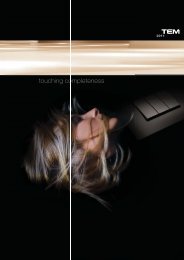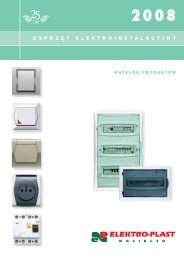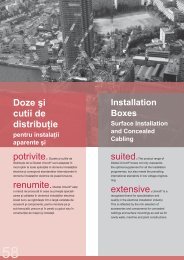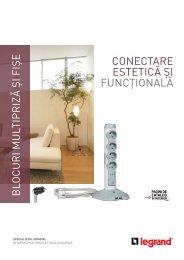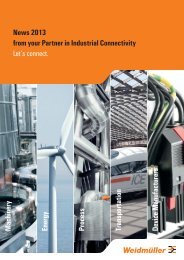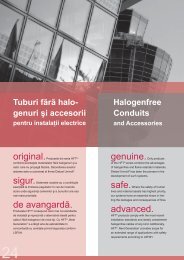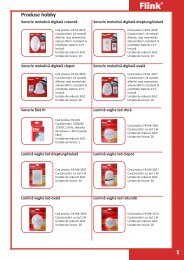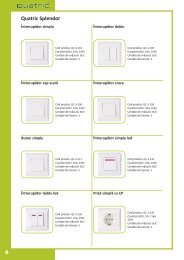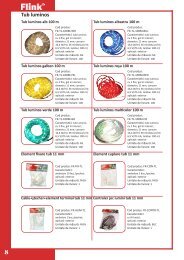Switch-Mode and Uninterruptible Power Supplies, Electronic Fuses ...
Switch-Mode and Uninterruptible Power Supplies, Electronic Fuses ...
Switch-Mode and Uninterruptible Power Supplies, Electronic Fuses ...
You also want an ePaper? Increase the reach of your titles
YUMPU automatically turns print PDFs into web optimized ePapers that Google loves.
Glossary<br />
D<br />
DC/DC converter<br />
Derating<br />
DC/DC converters are switched-mode power supplies that convert a specific<br />
DC voltage into another voltage. They are a variant of the AC/DC converter.<br />
DC/DC converters, in their simplest implementation, do not isolate voltage<br />
potentials. They are used only for adapting voltages. Improved DC/DC converters<br />
have isolated voltages. A safety isolating transformer in the power element<br />
ensures the required electrical isolation. Besides the voltage adaptation, the<br />
isolation of the voltage potentials is an important factor.<br />
For power supply devices, derating generally refers to the reduction in power as<br />
influenced by the surrounding temperature <strong>and</strong> the input voltage. A temperature<br />
derating often occurs starting at a surrounding temperature of 50 °C. The rated<br />
power is guaranteed up to this temperature. The available power continually<br />
declines as the temperature heats up above this level. This is typically specified<br />
in %/K. A voltage-dependent specification is another form of derating For<br />
switched-mode power supplies, the derating begins below a specific input<br />
voltage. So a switched-mode power supply with a wide input range can typically<br />
work under full power with 115 V AC input voltage. However at 85 V AC it can<br />
only produce 60 % of the power rating. The coefficient is usually specified in<br />
%/V.<br />
Glossary/Technical appendix<br />
Max. current [%IN]<br />
Temperature derating<br />
105<br />
100<br />
95<br />
90<br />
85<br />
80<br />
75<br />
70<br />
40 45 50 55 60 65 70 75<br />
Temperature [°C]<br />
Max. current [%IN]<br />
Voltage derating<br />
120<br />
100<br />
80<br />
60<br />
40<br />
20<br />
0<br />
70 90 110 130 150 170 190 210 230 250 270<br />
Main voltage [V]<br />
Diode modules<br />
Diode modules are used to construct a redundant power supply system. They<br />
are important for decoupling the power supply unit. Thus, a short circuit that<br />
occurs on the output of a power supply unit will not influence the output voltage.<br />
E<br />
Efficiency<br />
EMC (electromagnetic compatibility)<br />
The degree of efficiency is equal to the ratio of output power to input power <strong>and</strong><br />
is expressed in percent. The degree of efficiency can be between 70 <strong>and</strong> 90 %,<br />
depending on the dimensions <strong>and</strong> type of technology in use.<br />
Electromagnetic compatibility describes the interference emissions caused by an<br />
electronic device <strong>and</strong> the level of immunity against external electrical influences.<br />
Interference emissions can be caused by cabling <strong>and</strong> wires or by radiated<br />
emissions. Immunity measures the resistance against such wire-based emissions<br />
<strong>and</strong> against radiated emissions such as electrostatic fields <strong>and</strong> magnetic fields.<br />
Electric devices must also be protected against electrostatic discharges.<br />
W<br />
1366860000 – 2013<br />
W.7



